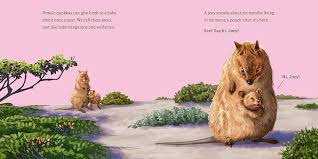"Female quokkas give birth to a baby
about once a year. We call them joeys,
just like baby kangaroos and wallabies.
A joey spends about six months
living in its mama's pouch after
it's born.
See?
Say hi, Joey!"
After having read the first two books in the Meet the Wild Things series, kids will be happy to have a chance to meet another endangered species. Written in first-person it gives the learning a more inviting feel and offers a candid look at this often-unfamiliar species. What do you know about quokkas?
There is a lot to learn. The interactive nature of the series offers young readers a chance to respond to the questions being asked of them, and the information they are gathering as they read. They are first asked to repeat a name that is likely to be unknown to them.
Quokkas have been dubbed 'the happiest animal in the world' by some who have met them. The lively illustrations certainly show that clearly. As well as being smiley, the quokka describes itself as curious, and shows that to be true by asking important questions:
"What's your name?
Have we met before?
Do you like smiling?"
Once the introductions are completed, the quokka goes on to share the many traits that make it so special. It is the size of a cat, likes to hop, is related to kangaroos and wallabies, and has babies called joeys, as one might expect. It is also nocturnal, eats mostly plants, and can go for weeks without food. Get this; it stores extra fat in its tail, just in case food is scarce.
Because most quokkas lived on Rottnest Island, off Australia's coast, not many people know much about them. For keen readers, that notion will end here. Although they may never meet a quokka, the facts presented in this accessible narrative nonfiction book will satisfy their curiosity for learning more about the endangered species in their world.
Ms. Rocco also explains how humans overtaking their habitat forced them to leave Australia and find refuge on Rottnest. Intense wildfires have caused more loss. Scientists are working diligently to protect the quokka and ensure it has a future.
John Rocco's realistic artwork offers a clear look at the quokka, its personality and its home. Kids who love animals will find lots to learn here. Back matter adds further facts, reasons for considering the quokka endangered, and organizations that are helping. A clear photo is provided as well.













No comments:
Post a Comment